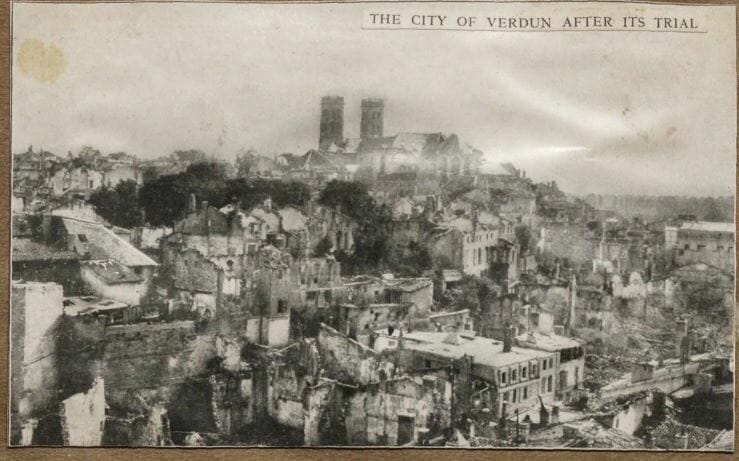It is widely regarded as the battle of the First World War; an enormous clash of attrition which epitomised the bloody stalemate of the war. The ten-month Battle of Verdun began 100 years ago, with German Chief of Staff General von Falkenhayn seeking to ‘bleed France white’ by launching an all-out attack on the narrow stretch of land at Verdun. Over a thousand German artillery guns fired upon the vastly inferior number of French troops – they had just 30,000 men, against 140,000 Germans – along a six-mile stretch of the French front. The battle which followed was to last for over 300 days. By looking at personal sources from Nineteenth Century Collections Online, the sheer scale of this part of the conflict is clear to see.
As an ‘American Girl’ serving in a French Army hospital on the frontline in France, the affectionately-named ‘Mademoiselle Miss’ saw it all. This is evident from her wartime letters, which were collated and published during the war in 1916. As the daughter of an ex-medical director of the US navy, Mademoiselle was stationed in France to assist the wounded. She was initially based on the French Riviera and the Mentone, before gaining Red Cross recognition and serving as a Lieutenant near the trenches of the Marne.
The front and inside cover of Mademoiselle Miss’s Letters from an American Girl Serving with the Rank of Lieutenant in a French Armey Hospital at the Front, c. 1916.
And so she was perfectly placed to offer her observations on events as they unfolded – including the Battle of Verdun. Her letters offer a first-hand glimpse into the sheer scale of the battle.
In her letter dated 27th February, just seven days into the fighting, Mademoiselle Miss notes how the ‘hammers of destruction hammer as they have never hammered since the beginning of time’.
Already, it appeared that there were signs of the great stalemate which was to follow; there was confusion as to who had the upper hand in the battle: ‘first we lost, then we gained, now no-one knows what is happening’.

What is in little doubt is the scale of the losses the conflict brought about. In her next letter, the readers were told of the 300 wounded who arrived at the hospital, leaving the Ambulance ‘quite demoralised’. Such a rush was unprecedented, and ‘paled all [her] former experiences’.

A similar impression of Verdun can be taken from the insights of American author, and wife of a French diplomat, Mary Alsop Waddington. Her War Diary was published in 1918, and is full of personal recollections of the conflict. In an entry from February 1916, she wrote that the fighting at Verdun was ‘terrific’. Again, the significance of Verdun to the outcome of the entire war emerges. For it was the ‘great chiefs’ (Joffre and Castelnau) who ‘hurled masses’ of their best troops on the French guns, doing everything in their power to overcome the crazed Germans – who fought ‘laughing and singing like madmen’. Like Mademoiselle Miss, Waddington was also keenly aware of the losses inflicted upon the French as a result of the fierce fighting, describing them as ‘very heavy’. Yet detailed knowledge of casualties was often missing, with no lists of those killed or wounded issued. This often meant a nervous wait for those left at home.

Both of these sources, found within Nineteenth Century Collections Online, present an unrivalled glimpse into the severity of the conflict at Verdun, which was in many ways epitomic of the entire war. As we pass 100 years since its start, understanding the gravity of Verdun through the eyes of those who lived through it is especially valuable.
In fact, there is perhaps no better way of capturing its essence than through pictorial evidence. Two photographs from Smithsonian Collections Online, one taken before the war and one taken after its conclusion, illustrate the devastation which ten months of battle brought to Verdun. It was a ten-month ordeal which changed its face forever.


For more information about the digital resources featured in this artice, or to request a trial, please get in touch with us today.



